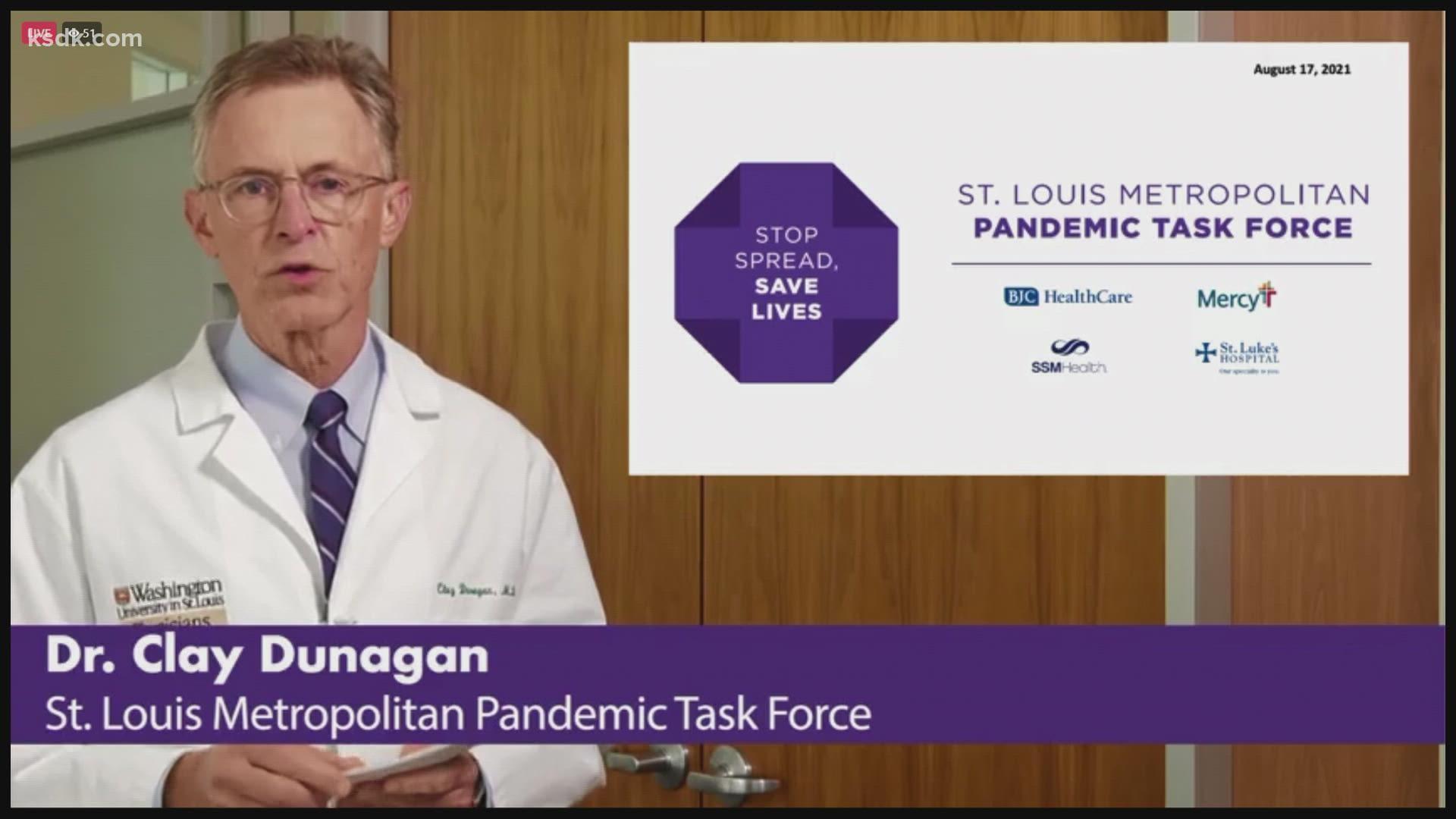ST. LOUIS — The leader of the St. Louis Metropolitan Pandemic Task Force said he is "cautiously optimistic" about the improvements in COVID-19 numbers reported this week.
Dr. Clay Dunagan, the leader of the task force, said cases are still increasing in the area, but at a slower pace than in previous weeks. He said it is still too early to tell if this is the start of a decline in cases, similar to what the southwestern portion of Missouri is seeing, or if it is just a temporary slowdown.
"Looking at the numbers, we have seen some flattening of case rates in the region. That could be just a temporary downturn in data, it could be some data reporting lag, but over the next week or so, we'll get a chance to see if, indeed, the masking and other measures we've taken are having the impact we expected," Dr. Dunagan said Tuesday. "I'm cautiously optimistic that the steps we have taken have made a difference."
On Tuesday, the task force reported 543 COVID-19 patients, down from 550 patients Monday. The number of new COVID-19 cases in the region increased over the last 14 days, but at a much slower rate than in previous weeks.
"It's encouraging to see this number drift back down," Dr. Dunagan said, "and hopefully we'll get it below the zero line when the cases are decreasing."
Of the 543 patients Tuesday, 84% are not fully vaccinated. Dr. Dunagan said most of the fully vaccinated people in the hospital have compromised immune systems or are elderly.
The task force leader said the health care system has been able to prevent some hospitalizations by administering monoclonal antibodies to people who have tested positive but are not yet sick enough to warrant a hospital stay. He said the treatments are being used more often and are complex to administer but have "clearly" been effective in preventing some hospitalizations.
Dr. Dunagan said many of the unvaccinated patients are younger than the patients they were seeing earlier in the pandemic. He said many of them could have avoided the hospital if they had been vaccinated.
Although numbers have slowed a bit, some area hospitals are having to limit certain procedures that normally result in ICU stays or the use of complicated life-support equipment. He said the St. Louis area is usually a place for other hospital systems to send their patients who need heart-lung bypass machines, but they have had to send at least one patient elsewhere for that treatment.
Twenty-one of the hospitalized patients were under the age of 18, and nine were under the age of 12. Six of the hospitalized children were in the ICU. Dr. Dunagan said many of the children had other health issues that put them at risk, but some did not.
"Many of these kids have other illnesses that put them at risk, but some of them are not very severe illnesses," Dr. Dunagan said. "So I don't want to leave the impression that a healthy kid can't get terribly ill with COVID."
Dr. Dunagan said these increases are coming at the worst possible time, as children prepare to go back to school. He said the best way to prevent things like school closures or outbreaks among children is to wear a mask and get vaccinated if you can.
The task force said the region is currently tracking a bit below their "best guess" projection that predicted more than 1,000 hospitalizations and 500 ICU patients by the end of September. Both projections are starting to trend closer to the lower limit line, which projects about 750 hospitalizations and 200 ICU patients by late September.
COVID-19 deaths have continued to increase in the area, and the seven-day average increased to 10 for the first time since Feb. 2.
The St. Louis Metropolitan Pandemic Task Force released the following data slides, combining figures from the four major health systems (BJC HealthCare, Mercy, SSM Health, St. Luke’s Hospital) that are part of the task force.
- New hospital admissions (data lagged two days) decreased – from 73 Monday to 69 Tuesday.
- The seven-day moving average of hospital admissions (data lagged two days) remained the same at 80 Tuesday.
- The seven-day moving average of hospitalizations increased – from 534 Monday to 538 Tuesday.
- Inpatient confirmed COVID positive hospitalizations decreased – from 550 Monday 543 Tuesday.
- Inpatient suspected COVID positive hospitalizations decreased – from 46 Monday to 21 Tuesday.
- The number of confirmed COVID-positive patients in the ICUs decreased – from 141 Monday to 138 Tuesday.
- The number of confirmed COVID positive patients on ventilators increased – from 93 Monday to 97 Tuesday.
- The number of COVID deaths increased – from 7 Monday to 11 Tuesday.
- The seven-day moving average of COVID deaths increased – from 9 Monday to 10 Tuesday.
- Across the system hospitals, 89 patients were discharged Monday, bringing the cumulative number of COVID-19 patients discharged to 25,380.
- Of the 550 hospitalized COVID patients in Task Force hospitals – 85 are fully vaccinated. That’s 16% of the patient population.
- There are 9 COVID-positive patients who are 11 years of age or younger in Task Force hospitals.
- There are 12 COVID-positive patients who are 12 years of age or older in Task Force hospitals.
- There are 3 COVID-positive patients who are 11 years of age or younger and in the ICU.
- There are 3 COVID-positive patients who are 12 years of age or older and in the ICU.
- Tuesday, staffed bed hospital capacity is at 88% an average across our task force hospitals. The ICUs are at 79% of their total staffed bed capacity.

